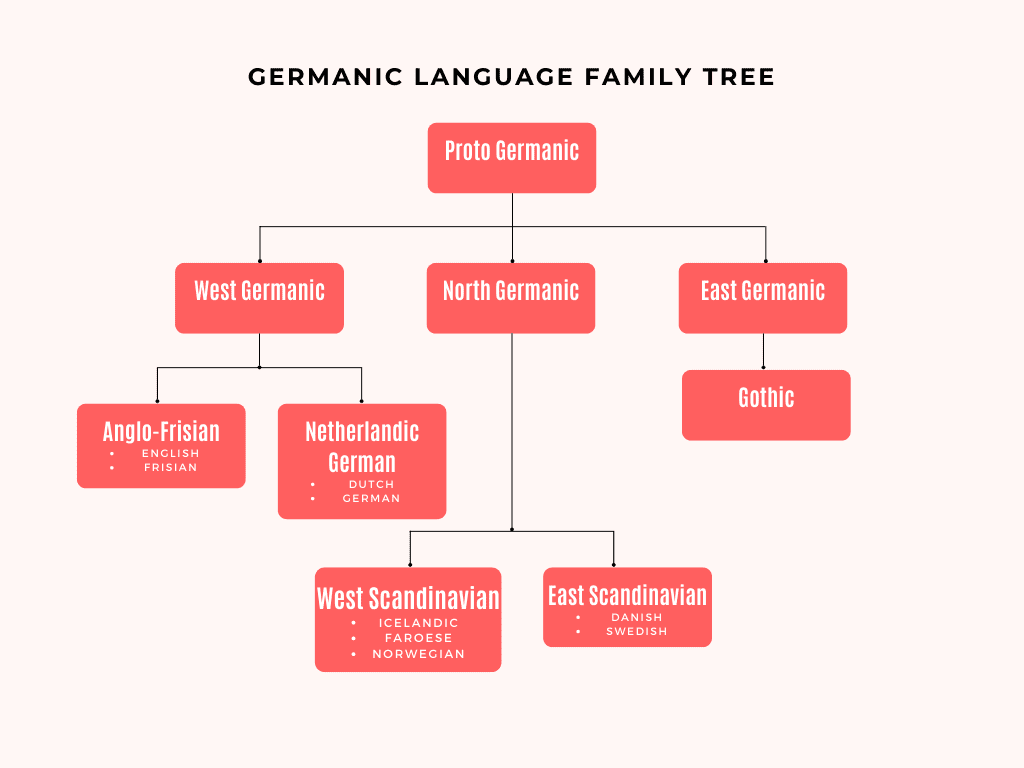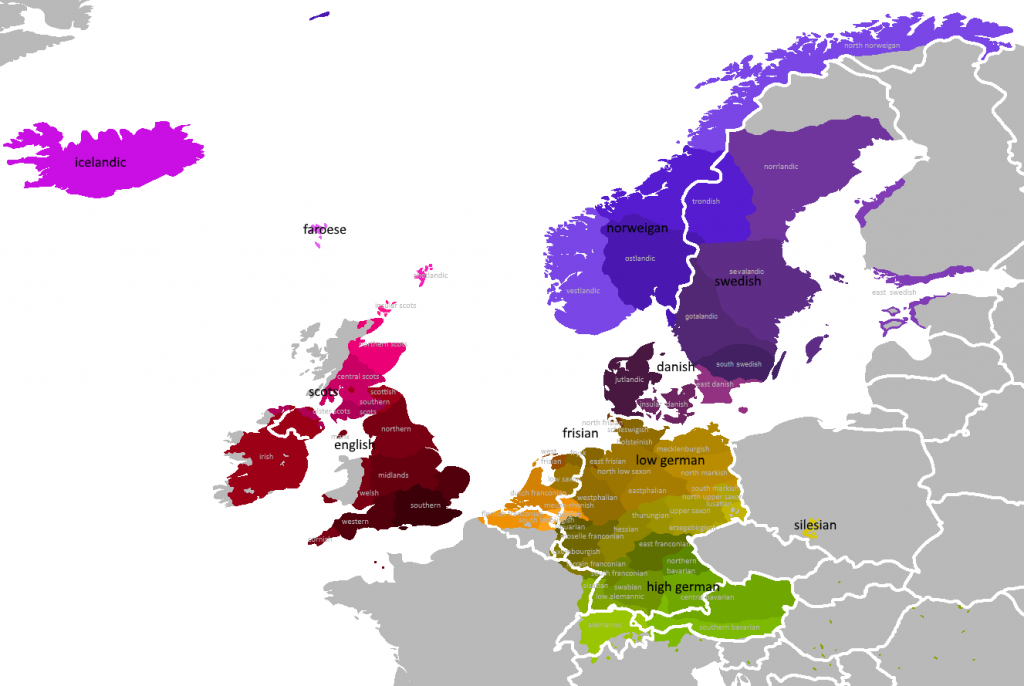When you think of Germanic languages, odds are you’re likely thinking of German, am I right? Well, you’re not wrong, but there are loads more languages that belong to the Germanic language family.
The Germanic languages are a branch of the Indo-European language family, that was once part of the language ancestor Proto-Germanic. The most widely spoken Germanic language is English, with an estimated 2 billion speakers worldwide.
But what exactly are they, and how do they differ from other language groups like, the Romance languages, spoken in other parts of Europe and Spanish Speaking countries, or Semitic languages, spoken in West Asia and other parts of Africa? Keep reading to find out!

What are the Germanic languages?

Source: Berlitz & Britannica
Languages, as all other things, tend to evolve and break off into separate groups that, over time become distinct dialects. As a result linguists have organised languages into separate family trees. The language at the top of the tree is known as the proto-language, or parent language.
All Germanic languages are thought to have descended from the Proto-Germanic language ancestor, united by subjection to the sound shifts of Grimm’s Law and Verner’s Law that took place in 500BC, and Proto-Germanic itself is believed to have been spoken after 500BC.
Germanic languages are often broken up into three separate groups by scholars: West Germanic, which includes English, Frisian, Dutch and German; North Germanic, which includes Icelandic, Faroese, Norwegian, Danish and Swedish; and East Germanic, now extinct and only comprises of Gothic and the languages of the Vandals, Burgundians and a few other tribes.
List of Germanic Languages

Now that we know a little more about the origins and different branches of Germanic languages, let’s take a look at all of them still spoken, their native country, and number of native speakers:
| Language | Branch | Country | Native Speakers |
|---|---|---|---|
| English | West Germanic | United Kingdom and Ireland | 400 Million |
| German | West Germanic | Germany | 130 Million |
| Dutch | West Germanic | The Netherlands | 23 Million |
| Flemish | West Germanic | Belgium and The Netherlands | 6.5 Million |
| Afrikaans | West Germanic | Southern Africa | 7 Million |
| Frisian | West Germanic | The Netherlands | 470 000 |
| Danish | North Germanic | Denmark | 6.0 Million |
| Norwegian | North Germanic | Norway | 5.3 Million |
| Swedish | North Germanic | Sweden | 9.7 Million |
| Icelandic | North Germanic | Iceland | 356 853 |
| Faroese | North Germanic | Faroe Islands | 53 000 |
How Similar are Germanic Languages?
Source: Babbel
Germanic languages share some similarities because of their common ancestor, from which they evolved. Let’s start by taking a look at some of the similarities in words of some of the Western Germanic languages.
| English | German | Dutch | Afrikaans | Frisian |
|---|---|---|---|---|
| Creative | kreativ | creatief | kreatief | kreatyf |
| Water | Wasser | water | water | wetter |
| Better | besser | beter | beter | better |
| Summer | Sommer | zomer | somer | simmer |
| Flower | Blume | bloem | blom | blom |
| House | Haus | huis | huis | hûs |
On paper, these can look extremely similar, especially comparing the spelling of different words. However, just because the words look alike, doesn’t mean they are mutually intelligible.
For example, German still maintains a complex grammatical case system, that the other got rid of. This along with the tricky German pronunciation, makes it a rather difficult language to master. Other Western ones also went through a number of sound shifts over the past two millennia, including a couple of large consonant shifts. A prominent example of these consonant shifts can be seen in the table above where the German words Wasser and besser have similar, but slightly different English, Dutch, Afrikaans and Frisian equivalents of water/wetter and better/beter.
Then if we look at the most widely spoken Germanic language, English – a whole range of other issues arise. When looking at the history of English, we see that it has absorbed thousands of words from Old Norse and French. That’s why even the languages most closely related to English, is nearly impossible for an English speaker to understand who doesn’t have another Germanic language in their language arsenal.
Which Germanic Language is the Most Useful to Learn?
Good news! If you are reading this article, then you already speak a Germanic language – English. This gives you a solid foundation to learn other languages of this family, since they’re all related, and thus quite similar.
If you’re looking for some of the easiest languages to learn start with either Dutch or Norwegian. However, if you want to talk to a greater number of people, then German is the better option. That is no secret that people with Germanic languages as their mother tongues tend to speak very fluent English, but if you want to live, work or study in these countries, learning the local languages will be very helpful for you to fit in the society.
If you want to start out slow, or you just have a general interest in learning a few things about some of the Scandinavian languages, check out our articles on how to say thank you in Swedish, and how long it takes to learn Norwegian.

FAQs
Aside from German, there are about 47 living Germanic languages spoken today. Divided into three main branches, West-, North-Germanic and East-Germanic (extinct).
Many factors such as, grammar, phonology and vocabulary determine a language’s ancestry. Based on those factors in English, it shows strong Germanic roots, meaning English is a proud member of the Germanic language family.
No, Germanic in linguistics refers to a family of languages that themselves belong to the Indo-European language group, which descended from the ancestral language we now call Proto-Germanic. Whereas, German refers to the language varieties and people of the nation of Germany.
Germanic languages are divided into two groups (the third, East-Germanic is now extinct), West-Germanic which includes languages like English, German, Dutch and Afrikaans; and North-Germanic which includes languages like, Swedish, Norwegian and Danish.
The main difference between these two language families is of course the ancestral languages from which they descended. Romance languages descended from Vulgar-Latin, whereas Germanic ones descended from Proto-Germanic. As a result, there are many differences between these two, in terms of intonation patterns and grammar.

Open Your Door to Germanic Languages!
The Germanic languages are spoken natively by a population of about 515 million people, this makes the Germanic language family a very useful language family to learn, be it for travel or work. And if you’re an English speaker you have the advantage that English is related to the rest of the Germanic languages, which means it’ll be a bit easier for you to learn and master!
Now that you’ve learned a bit more about these languages, their origin and history I hope you have become inspired to learn a new language, hopefully from the Germanic family. If so check out the wide range of articles on this topic, and many more at AmazingTalker.

















